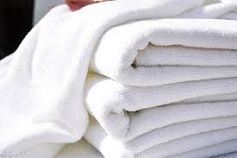 NATIONAL REPORT—Whether traveling for business or pleasure, every guest wants their hotel to be a comforting home away from home. In fact, studies have demonstrated that customers value room quality regardless of whether they’re staying at a luxury resort, an economy property or somewhere in between. Gallup’s 2014 Hospitality Industry study found that guests would be willing to pay more for improved services such as Internet connectivity, comfortable beds, and quick customer service. The study also found that the quality of a guest’s first stay has a strong impact on their likelihood of booking future stays.
NATIONAL REPORT—Whether traveling for business or pleasure, every guest wants their hotel to be a comforting home away from home. In fact, studies have demonstrated that customers value room quality regardless of whether they’re staying at a luxury resort, an economy property or somewhere in between. Gallup’s 2014 Hospitality Industry study found that guests would be willing to pay more for improved services such as Internet connectivity, comfortable beds, and quick customer service. The study also found that the quality of a guest’s first stay has a strong impact on their likelihood of booking future stays.
One way to provide a welcoming stay for guests is by supplying high-quality linen such as bath towels and bed sheets. If linen carries an odor, or wrinkles, turns grey, is stained or torn, guests may question a property’s overall cleanliness and attentiveness to their needs. It’s important for hotels to set up an effective linen purchase and maintenance program in order to ensure guests enjoy their stay, and want to rebook in the future.
Selecting & Caring for Linen
Poor quality can cause pilling, seam fraying, excessive shrinkage and loop slippage, also known as snagging, and hotel linen to tear after 30 or so wash and dry cycles. A linen purchase and maintenance program is the key to providing guests with linen they’ll love and linen that will last.
Managers should consider the following best practices when purchasing and caring for linen:
1. Know the difference between production and quality specifications. To avoid quality issues, it’s important for laundry managers to understand that buying specifications have more or less been defined by the textile manufacturers and are typically production specifications, not quality specifications. For example, weight per square meter is often looked at as being an important buying parameter. In reality, there is hardly any relation between weight per square meter and the quality of the fabric.
2. Review the initial tensile strength of the fabric. Imagine that a hotel laundry purchases new bed linen with high tensile strength of 60 decaNewton (dN) in the warp direction, but only 35 dN in the weft direction. The result is that the tensile strength of the weft is reduced to below 20 dN after approximately 40 to 50 wash cycles. The bed linen could tear more easily during high speed or final extract or during unloading of the washer extractor when this lower limit of tensile strength has been reached. This damage is avoidable with greater consideration of linen strength in both the warp and weft direction (see below chart).
The table below highlights the recommended minimum tensile strength when buying new linen.

3. Note whether the linen is a blend of different fabrics. Bed linen made from 100 percent cotton is more comfortable compared to polyester/cotton blends. Although polyester/cotton bed linen has a slightly longer lifespan, managers should recognize that guest satisfaction and comfort is more important. Plus, incorporating polyester into the yarns of a woven product makes fatty and oily stain removal slightly more difficult.
4. Keep linen from coming into contact with objects that can cause damage. Tearing can also be the result of linen coming into contact with sharp objects such as bends in the metal plates of a laundry chute, damaged transport trolleys, sharp objects left inside the linen when starting the wash etc.
5. Install a wash process that does not cause damage. Implementing the proper products and procedures will reduce the opportunity for damage during the wash process, which in turn extends the lifespan of linen. For instance, lower wash temperatures results in less damage. If bleach must be used, it’s important to select a type of bleach that will extend the lifetime of the linen
The Impact of Poor Linen
Hotel linen can have a big impact on brand image, the bottom line and sustainability.
• Brand image—Hotel guests should not be greeted with worn out, torn towels in the bathroom or imperfect bed linen, no matter the price they paid for the room. Issues may arise more easily if a property purchases poor-quality linen. For instance, linen can stain, shrink or tear more easily after fewer washes, giving them an unpleasant appearance. Poorly chosen linen may also be less comfortable, such as those made from a polyester/cotton blend.
• The bottom line—According to the Textile Rental Services Assn. (TRSA), linen replacement can carry a cost of up to 25 percent when looking at the overall cost of any laundry. A hotel may not want to invest in higher-quality linen upfront. However, poor-quality linen can end up costing a property much more in the long run. This is because poor-quality linen or linen that is not cared for properly will have a shorter lifespan than those that are purchased and maintained with guest satisfaction in mind. More frequent replacement will result in higher spend on linen replacement. Although a hotel may not want to spend a higher price for linen, it provides savings in the long run. For a 400-room hotel, a professional linen management and care system can result in a savings of $14,000 to $22,000 dollars per year.
• Sustainability—According to the American Hotel & Lodging Assn., a typical hotel recycles over one million pounds of standard recyclables such as cardboard, glass and plastic each year. However, textile recycling is often overlooked; although 95 percent of textiles are recyclable, only about 15 percent are currently being recycled in the United States. When hotels do not invest in lasting linen, these textiles are thrown away more often. Additionally, growing cotton is not the most environmentally friendly process since large quantities of water, pesticides and herbicides are used to achieve high yields. Lengthening the lifespan of linen strongly reduces the amount of pesticides and herbicides used globally, as well as water consumption in countries where water is already scarce.
Dreaming of Better Linen
Many negative online hotel reviews are accompanied by mentions of stained, torn and wrinkled linen. And with these reviews publicly available to other customers considering your property, it’s important for laundry managers to understand easily-avoidable linen issues. Whether operating an expensive or budget property, or something in between, it’s important to give guests five-star sheets and towels. Developing and following a well-thought-out linen purchase and maintenance program will help prevent common linen complaints, leaving guests happy and open to rebooking in the future, while also improving the bottom line and increasing sustainability profile.
Simon Hemmes is the Senior Global Application Expert-Fabric Washing with Sealed Air’s Diversey Care division. For more information, click here.






